
Approaching the Horizon
BLOGS
It was 1982, the first Lebanon war, when the Israel Defence force (IDF) invaded southern Lebanon. Fending them off was a force of Lebnese soldiers augmented with 25,000 odd Syrian soldiers who had dug-in for a battle of attrition. They had brought in 79 missile launchers, hundreds of radar-guided guns and several 2k12 Kub batteries. Incredibly, the Israelis pinpointed their flexible locations time after time and took them out unerringly with easy. Were the mobile Syrian SAM batteries too slow and predictable? With little or no early warning about counterattacks, they seemed to be sitting ducks! Dubbed Operation Mole cricket 19, these were among the first 'DEAD' missions to be carried against a sophisticated air defense system.
Op. Mole Cricket 19, proved the worth of the drones in “modern” warfare. IAI Scout proved its mettle first in the Sinai exercise which involved crossing Suez Canal despite being dismissed as just a toy. “Before that” says Dubester “Nobody cared about it”. But officers soon realized the live video feed from the Scout’s camera helped troops tremendously, simplifying the challenges in the exercise. “We had only four hours’ endurance at the time, and when we needed to land, the troops said no, it’s not acceptable”, recalls Yair Dubester the father of the IAI Scout drone. Suddenly the toy that was dismissed had become essential. With a laser designator for rockets and the capability to work with Boeing 707-3W6C SIGINT and E2C Hawkeye AWACS at that time, the little Scout was a deadly little bastard, even by today’s standards. And that’s where we witnessed the start of an era.
Fast-forward to (in)famous and iconic Predator, Reaper, Bayraktar TB-2, or IAI Harop. Today these drones have taken over duties from ISR, EW, hunting Al-Quaeda HVTs, assassinating Qasem Solemani, kamikaze DEAD-ing Armenian sams, vaporizing Russian armored formations, Maritime surveillance, submarine hunting, and a lot more. It hits blunt that MQ-1 was first flown in 1994, which is more than 25 years ago, and still, we haven’t seen any significant change in the way these machines operate. Slow, high flying stable airframe, remotely operated. Yes, there have been many improvements, and machines today are vastly different than they used to be, obviously, but there is no radical change in their mode of operation and their purpose.
MALE drones have their limitations such as susceptibility to the high altitude SAMs and no teeth against BVR combat jets, low speed, low agility for evasive maneuvers against incoming missiles, inability to fly at low altitudes to avoid detection, inability to carry internal ECM suite*, limited air to air weaponry, the big lag between operator input to action which could be detrimental in the air to air combat missions (you see where I am going). The latency or lag is the biggest caveat in Satcom and long-range UAV controls with various relays adding latency at every hop. With chances of peer conflict increasing every day, these pieces of hardware are obsolescent and could be rendered obsolete outside permissive environments i.e. in heavy IADS populated battlefields.
Now, with every established state moving towards drone warfare in the future, there is a visible pattern common among all developments. Stealth UAVs. Though the concept is not new, the Boeing X-45 flew first in 2002 and had internal weapon bays for carrying air-to-ground light weaponry. What’s game-changing here is the way these drones will be employed in combat and the way these drones will be controlled. As we already know, the drone no matter how good it is, when controlled from ground stations has limited range. When controlled from grounds via single or multiple relays, provide latency in decision-making. The same is the case with Satcom control, it has the range but poor latency. (* represents exception)


Dull, Dirty, Dangerous- IAI Scout, the inception
Enter the Man-Unmanned Teaming (MUMT). Where the UAVs will be automated to a vast degree- ATOL, waypoint navigation, performing BFM, releasing air to ground payloads, releasing BVR missiles, buddy refueling planes, carrying out dogfights against fighters, and even sacrifice themselves to save manned fighters. Seems like there is no need for a man to control these things. But there are several reasons why MUMT is a better approach to UAV combat. The man will always have thinking in his mind, anticipating enemy psychology, man will always have ethics in combat, man has instincts against traps and decoys, man has experience. Several more things algorithms simply can’t have. Algorithms and AI can defeat a human in dogfights but don’t have decision-making ability out of their programming.
That’s why the man-in-the-loop is the optimal balance between manned and unmanned aerial combat. Today we are witnessing yet another Dreadnaught effect after the emergence of BVR missiles and long-range SAMs. Like how sophisticated Soviet SAMs made U.S. planners invest in the Lockheed Have Blue concept, which later came out as F-117 Nighthawk. The design was radical and revolutionary, it changed the way aerial combat will be seen forever. Advancements in BVR missiles and HOBS in IR-guided missiles rendered the super-maneuverability of jets of that era (Su-27 family, Mig-29, F-16, F-15) unnecessary. BVR missile, no matter how hard you pull the Gs, will still score the hit when inside the NEZ, and IIR guided missile with helmet cueing will always out-maneuver any fighter with its 50G turns. The reason why today’s planes focus more on Low Observability, ECM, and stealth; agility is no longer the primary design goal. In a similar way, MUMT consisting of stealth UAVs as wingmen and several constituent hardware will reduce the effectiveness of modern manned jets, or the enemy has to face unacceptable attrition.
In MUMT systems, the AWACS basically tracks targets from far away as it usually does in manned combat, but this time the data here is not consumed by the pilot to take action, but by a computer on board the mother ship (which may or may not be manned). The question must rise, why not directly send data to the UAVs via the AWACS? The reason is the cost. Significant processing power is employed to process raw data into desirable attack vectors against the threat which is usually done by the mind of an experienced fighter pilot but one human cannot control the UAVs while operating his own fighter. Not even the brain of a WSO is capable to command a dozen different UAVs. That’s why there is the heavy implementation of Artificial Intelligence and machine learning to crunch large amounts of data and spit out the commands for drones. All human has to do is press the button for final authorization.
The mothership then feeds all processed data about the rough target location to the drones; drones can pinpoint the target’s location with its onboard sensors like Electro-Optical sensors and release the payload, which can be anything from air-air missiles to a PGM. So every drone getting such high-end computation will drive its costs up and it’s even more costly when these UAVs sometimes need to sacrifice themselves. So the expensive computational equipment is skipped from every drone, so they are mere slaves of the mothership giving commands. Mothership can be based on any manned fighter jet, most likely Jaguar Max or LCA for the CATS system. But In reality, there are several different components in the system. Discussing all of them in detail is out of the scope of this article.

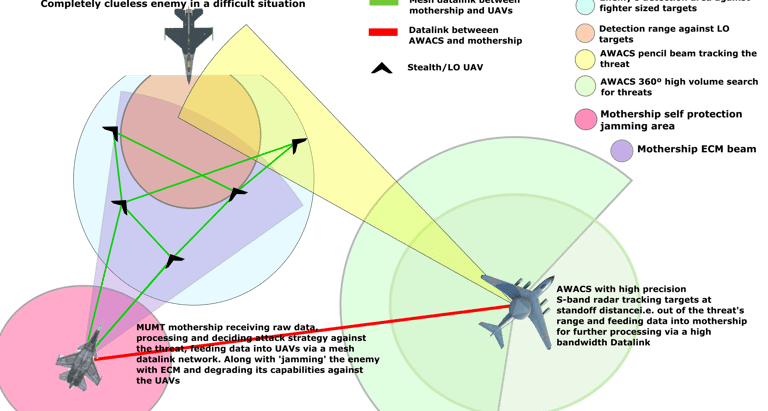
Basic illustration of the Manned-Unmanned Teaming concept
PS- assume ISTaR platforms instead of AWACS for ground strike missions, Reader is advised to view this page in light mode
This might sound like futuristic, but the future is much closer than we think. It’s right before the end of this decade when we might see stealth UAV wingmen flying alongside manned jets in active missions. These are no more technology demonstrators or concepts. They are being actively put in use on-board American carriers for buddy refueling jobs. Just a matter of time before they will replace manned aircraft for one-way missions where it’s not worth losing a man or expensive jets. Even the Chinese despite having a massive MALE UAV fleet are investing in stealth UAV concepts, because they know that usual, slow, UAVs are just cannon fodder against sophisticated SAMs. Speed and stealth are crucial for survival.
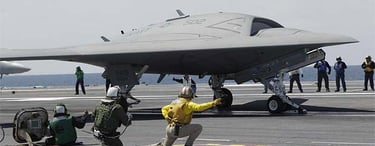

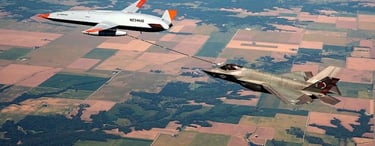






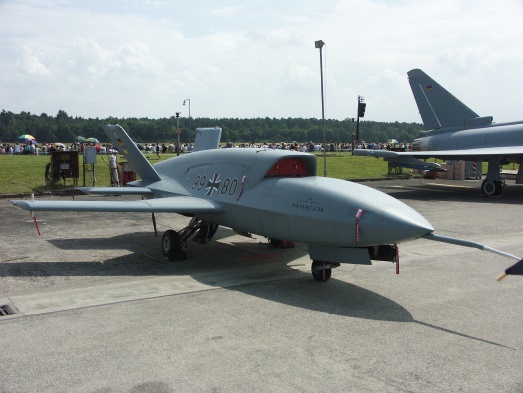

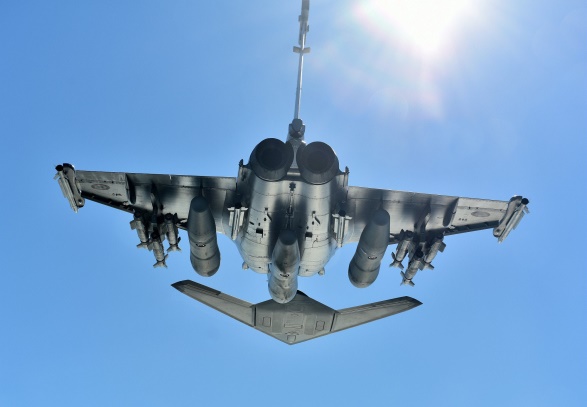
(top left) Northrop Grumman X-47B taking off from USS George H.W. Bush (CVN-77), (top right) MQ-25B Stingray refuelling F-35C, (middle) Iranian mock-up of captured RQ-170 Sentinel, (bottom left) EADS Barracuda, (bottom right) Dassault nEUROn flying next to some aircraft

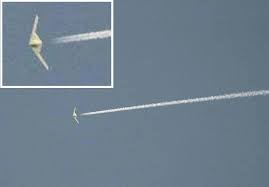
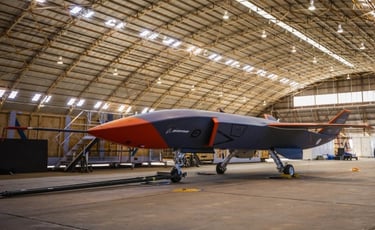



(top left) The mysterious RQ-180 pic captured over Edwards AFB California,(top right) Boeing Australia MQ-40 Spark Loyal Wingman, (middle) Kratos XQ-58A Valkyrie, (bottom) BAE systems Taranis
In all this development, where does India stand? Being 4th strongest military in terms of sheer quantity and firepower and in 3rd in spending, India must have its own UAV projects. And it does. India has its own MUMT solution dubbed as CATS (Combat Air Teaming System). As the name suggests, it’s a teaming system, which is non-homogenous in its UAV components. It has a wide range of UAVs ranging from HALE to mini drone swarms all in one system being operated alongside executing different tasks. All under the control of ACID (Air Combat Intelligence Development) and command of the manned mothership. Let’s not discuss the components of CATS and components since all information is available on the internet.
India does have its UAV projects in the works. But we might see the results after a decade or so if DRDO delivers it on time. What if war breaks out tomorrow? India’s both enemies have decently armed drone fleets. India doesn’t have even a single armed drone in service, let alone a fleet of them. Recent news of Chinese planes breaching negotiated airspace zones along the LAC is nothing short of alarming, the Chinese are here for a war. UAV scenario in India is, if I may bluntly put it, grim and cold. Even a comparison between both countries' (China and India) drone fleet is completely pointless. Dismissing Chinese hardware (drones) as substandard is outright myopic and delusional. Drones are cheap and expendable, and China is currently a world leader in commercial drones. The technology is obviously applicable to the military.

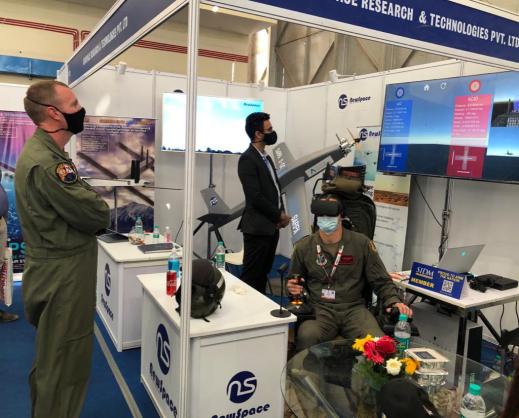
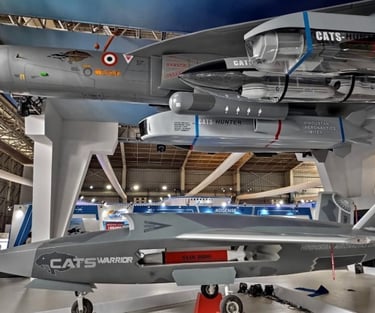

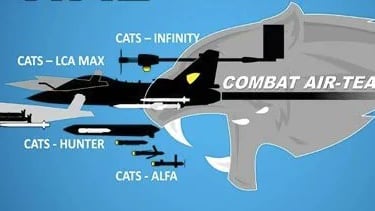

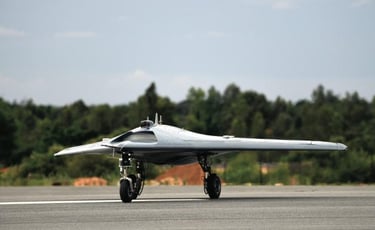



(top left) USAF pilots testing ACID AI, (top right) CATS mock-ups Aero India 2021, (center left) CATS poster by HAL, (center right) SWIFT UAV which is a scaled-down technology demonstrator for the Ghatak UCAV, Swift took its first flight in 2022, may or may not be a part of CATS system, (bottom) NAL HAPS tech demonstrator. PS- Aura which was called later Ghatak is no more dubbed as so. It’s now IUSA (Indian Unmanned Strike Aircraft)
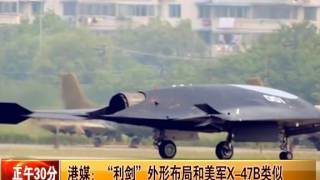

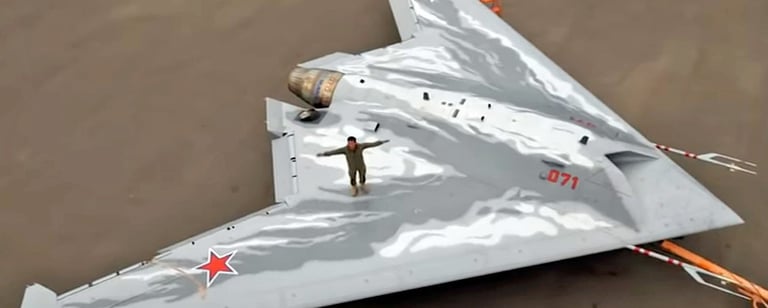

(top) Hongdu G-11 Stealth UCAV designed by AVIC, (bottom) Sukhoi S-70 Okhotnik
Turkey with its tiny $13B budget, has world-class drones in a quantity. Doesn’t matter if the Turkish President’s son-in-law owns Baykar, the glorious Bayraktar TB2 manufacturer, Turkey has operational, indigenous drones. I will not even mention Akinci which has standoff weapons carrying capability. It’s very beneficial for budget-conscious countries like Pakistan. But the thing is, you have the capability or, you don’t.
It’s always better to have it than regret it later.
I did say un-stealthy MALE drones are the cannon fodder against SAM systems. But no SAM system is invincible, not even Iron Dome or S-400. There will always be holes in the coverage which can be exploited. Drones are deadly in such permissive conditions. India has a long and mountainous border with both China and Pakistan, where surveillance radars perform sub optimally. Airspace cannot always be airtight. There are gaps in CAP too while rotating planes between the sorties, which can be exploited by small drones.
Yet Indian planners with massive defence spending haven't yet decided the roadmap on MALE/HALE fleets, not even imported ones. Even MQ-9B deal was cancelled, MQ-9B Naval versions had unparalleled capabilities and could augment for MPA platforms. Its disappointing and frustrating to watch Indian progress in this field.
PS-
The author expects the reader to do their own research about a few acronyms and some missing information in the article. Spoon-feeding is discouraged. After all the motive is to generate curiosity among the new generation of enthusiasts.
The article is inspired by the book ‘Drone Wars’ by Seth J. Frantzman.
The article expresses the thoughts of the author, we do not claim the information to be authentic or accurate
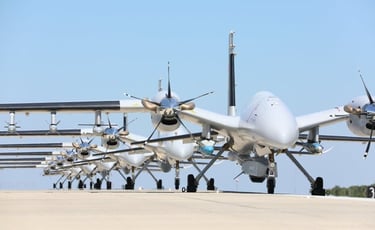

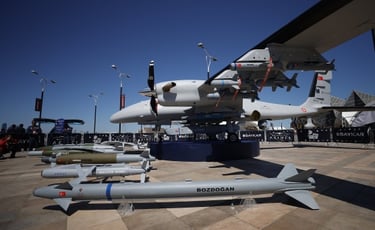


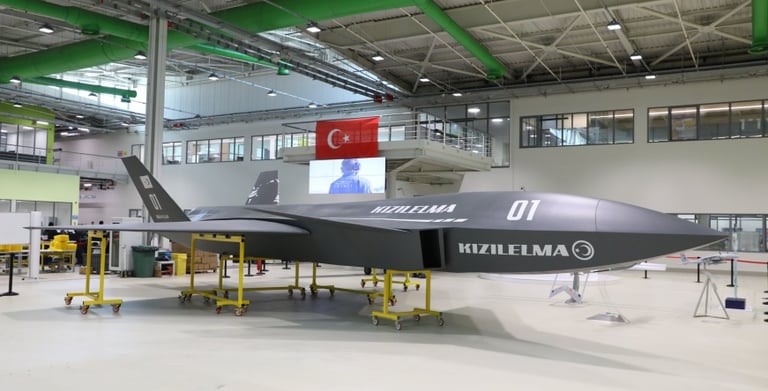
(top left) the gorgeous Akinci UCAV carrying SOM-B cruise missile with 275km range, (top right) Akinci to get Bozdogan CCM for air-air capability, (bottom) TAI Kizilelma stealth UCAV full scale mock-up
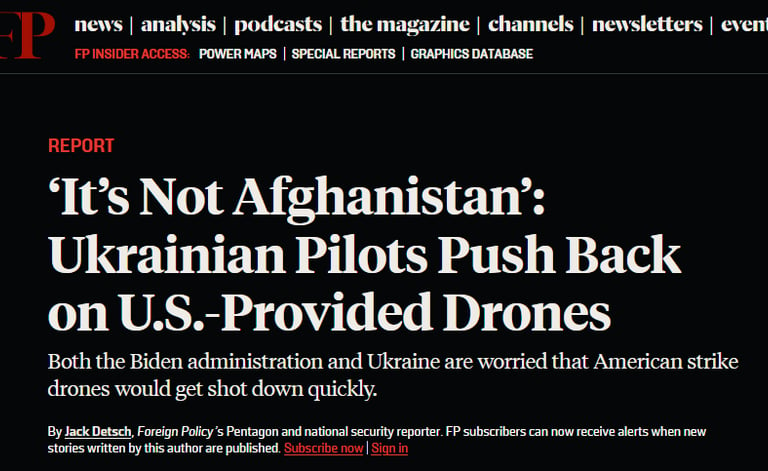



(top) courtesy- foriegnpolicy, (bottom) Bayraktar TB-2 shot down in Ukraine 2022
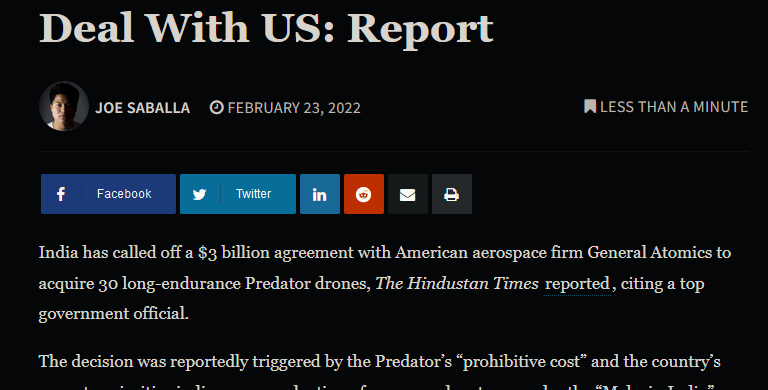

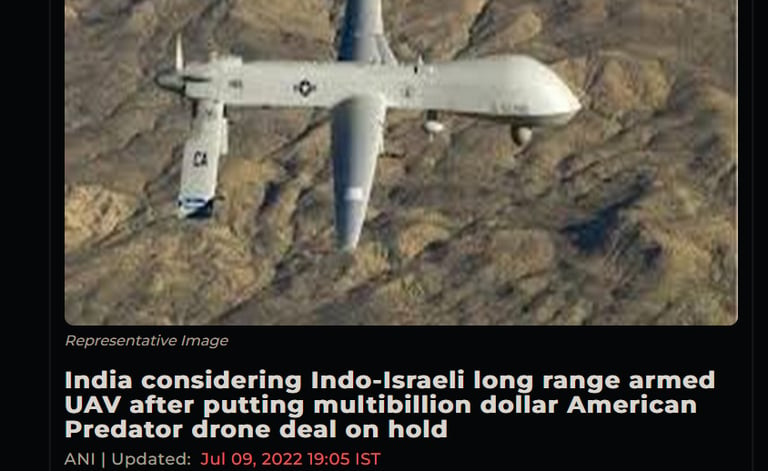



(top) courtesy- defencepost, (bottom left ) courtesy- ANI, (bottom right) tired pepe
